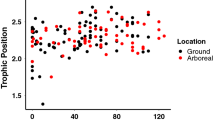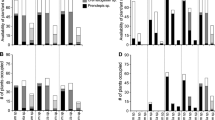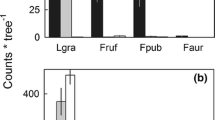Abstract
In most terrestrial ecosystems ants (Formicidae) as eusocial insects and spiders (Araneida) as solitary trappers and hunters are key predators. To study the role of predation by these generalist predators in a dry grassland, we manipulated densities of ants and spiders (natural and low density) in a two-factorial field experiment using fenced plots. The experiment revealed strong intraguild interactions between ants and spiders. Higher densities of ants negatively affected the abundance and biomass of web-building spiders. The density of Linyphiidae was threefold higher in plots without ant colonies. The abundance of Formica cunicularia workers was significantly higher in spider-removal plots. Also, population size of springtails (Collembola) was negatively affected by the presence of wandering spiders. Ants reduced the density of Lepidoptera larvae. In contrast, the abundance of coccids (Ortheziidae) was positively correlated with densities of ants. To gain a better understanding of the position of spiders, ants and other dominant invertebrate groups in the studied food web and important trophic links, we used a stable isotope analysis (15N and 13C). Adult wandering spiders were more enriched in 15N relative to 14N than juveniles, indicating a shift to predatory prey groups. Juvenile wandering and web-building spiders showed δ15N ratios just one trophic level above those of Collembola, and they had similar δ13C values, indicating that Collembola are an important prey group for ground living spiders. The effects of spiders demonstrated in the field experiment support this result. We conclude that the food resource of spiders in our study system is largely based on the detrital food web and that their effects on herbivores are weak. The effects of ants are not clear-cut and include predation as well as mutualism with herbivores. Within this diverse predator guild, intraguild interactions are important structuring forces.






Similar content being viewed by others
References
Agusti N, Shayler P, Harwood JD, Vaughan IP, Sunderland KD, Symondson WOC (2003) Collembola as alternative prey sustaining spiders in arable ecosystems: prey detection within predators using molecular markers. Mol Ecol 12:3467–3475
Albers D (2002) Nahrungsnetz und Stoffdynamik auf extensiv bewirtschafteten Ackerflächen - die Untersuchung stabiler Isotope (13C, 15N) im Zersetzer-Subsystem. PhD thesis, Göttingen
Blüthgen N, Gebauer G, Fiedler K (2003) Disentangling a rainforest food web using stable isotopes: dietary diversity in a species-rich ant community. Oecologia 137:426–435
Brüning A (1991) The effect of a single colony of the red wood ant, Formica polyctena, on the spider fauna (Araneae) of a beech forest floor. Oecologia 86:478–483
Cabana G, Rasmussen JB (1994) Modelling food chain structure and contaminant bioaccumulation using stable nitrogen isotopes. Nature 372:255–257
Cronin JT, Haynes KJ, Dillemuth F (2004) Spider effects on planthopper mortality, dispersal, and spatial population dynamics. Ecology 85:2134–2134
DeNiro MJ, Epstein S (1978) Influence of diet on the distribution of carbon isotopes in animals. Geochim Cosmochim Acta 42:495–506
DeNiro MJ, Epstein S (1981) Influence of diet on the distribution of nitrogen isotopes in animals. Geochim Cosmochim Acta 45:341–351
Denno RF, Mitter MS, Langellotto GA, Gratton C, Finke DL (2004) Interactions between a hunting spider and a web-builder: consequences of intraguild predation and cannibalism for prey suppression. Ecol Entomol 29:566–577
von Ende CN (1993) Repeated-measures analysis: growth and other time-dependent measures. In: Scheiner SM, Gurevich J (eds) The design and analysis of ecological experiments. Oxford University Press, Oxford, pp 134–157
Finke DL, Denno RF (2003) Intra-guild predation relaxes natural enemy impacts on herbivore populations. Ecol Entomol 28:67–73
Finke DL, Denno RF (2004) Predator diversity dampens trophic cascades. Nature 429:407–410
Gibb H (2003) Dominant meat ants affect only their specialist predator in an epigaeic arthropod community. Oecologia 136:609–615
Halaj J, Ross DW, Moldenke AR (1997) Negative effects of ant foraging on spiders in Douglas-fir canopies. Oecologia 109:313–322
Hölldobler B, Wilson EO (1995) The ants. Springer, Berlin Heidelberg New York
Kajak A, Breymeyer A, Pętal J (1971) Productivity investigation of two types of meadows in the vistula valley. IX. Predatory arthropods. Ekol Pol 19:223–233
Kajak A, Breymeyer A, Pętal J, Olechowicz E (1972) The influence of ants on the meadow invertebrates. Ekol Pol 20:163–171
Kempson D, Lloyd M, Ghelardi R (1963) A new extractor for woodland litter. Pedobiologia 3:1–21
Kling GW, Fry B, O’Brien WJ (1992) Stable isotopes and planktonic trophic structure in Arctic lakes. Ecology 73:561–566
Laakso J, Setälä H (2000) Impact of wood ants (Formica aquilonia Yarr.) on the invertebrate food web of the boreal forest floor. Ann Zool Fenn 37:93–100
Lajtha K, Michener RH (eds) (1994) Stable isotopes in ecology and environmental science. Blackwell, Oxford
Lang A (2003) Intraguild interference and biocontrol effects of generalist predators in a winter wheat field. Oecologia 134:144–153
Lawrence KL, Wise DH (2000) Spiders predation on forest-floor Collembola and evidence for indirect effects on decomposition. Pedobiologia 44:33–39
Lawrence KL, Wise DH (2004) Unexpected indirect effect of spiders on the rate of litter disappearance in a deciduous forest. Pedobiologia 48:149–151
Lenoir L, Bengtson J, Persson T (2003) Effects of Formica ants on the soil fauna – results from a short-term exclusion and a long-term natural experiment. Oecologia 143:423–430
Macko SA, Lee WY, Parkere PL (1982) Nitrogen and carbon fractionation by two species of marine amphipods: laboratory and field studies. J Exp Mar Biol Ecol 63:145–149
Magnusson WE, Carmozina de Araújo M, Cintra R, Lima AP, Martinelli LA, Sanaiotti TM, Vasconcelos HL, Victoria RL (1999) Contributions of C3 and C4 plants to higher trophic levels in an Amazonian savanna. Oecologia 119:91–96
McNabb DM, Halaj J, Wise DH (2001) Inferring trophic positions of generalist predators and their linkage to the detrital food web in agroecosystems: a stable isotope analysis. Pedobiologia 45:289–287
Minagawa M, Wada E (1984) Stepwise enrichment of 15N along food chains: further evidence and the relation between 15N and animal age. Geochim Cosmochim Acta 48:1135–1140
Nentwig W (1986) Non-web-building spiders: prey specialists or generalists. Oecologia 69:571–576
Nyffler M (1999) Prey selection of spiders in the field. J Arachnol 27:317–324
Oelbermann K, Scheu S (2002) Stable isotope enrichment (δ15N and δ13C) in a generalist predator (Pardosa lugubris, Araneae: Lycosidae): effects of prey quality. Oecologia 130:337–344
Oraze MJ, Grigarick AA (1989) Biological control of aster leafhopper (Homoptera: Cicadellidae) and midges (Diptera: Chironomidae) by Pardosa ramulosa (Araneae: Lycosidae) in California rice fields. J Econ Entomol 82:745–749
Otto D (1965) Der Einfluss der Roten Waldameise (Formica polyctena Först.) auf die Zusammensetzung der Insektenfauna (ausschliesslich gradierende Arten). Collana Verde 16:250–263
Owens NJP (1987) Natural variations in 15N in the natural environment. Adv Mar Biol 24:389–451
Pętal J, Breymeyer A (1969) Reduction of wandering spiders by ants in a Stellario-Deschampsietum Meadow. Bull Acad Pol Sci Cl II 17:239–244
Petelle M, Haines B, Haines E (1979) Food preferences analyzed using 13C/12C ratios. Oecologia 38:159–166
Peterson BJ, Fry B (1987) Stable isotopes in ecosystem studies. Annu Rev Ecol Syst 18:293–320
Pitkin BR (1988) Lesser dung flies, Diptera: Sphaeroceridae. Royal Entomological Society of London, London
Polis GA, Myers CA, Holt RD (1989) The ecology and evolution of intraguild predation: potential competitors that eat each other. Annu Rev Ecol Syst 20:297–330
Ponsard S, Arditi R (2000) What can stable isotopes (δ15N and δ13C) tell about the food web of soil macroinvertebrates. Ecology 81:852–864
Post DM (2002) Using stable isotopes to estimate trophic position: models, methods, and assumptions. Ecology 83:703–718
Reineking A, Langel R, Schikowski J (1993) 15N, 13C-on-line measurements with an elemental analyzer (Carlo Erba, NA 1500), a modified trapping box and a gas isotope mass spectrometer (Finnigan, MAT 251). Isotopenpraxis 29:169–174
Riechert SE, Bishop L (1990) Prey control by an assemblage of generalist predators: spiders in an Garden test systems. Ecology 71:1441–1450
Riechert SE, Lawrence K (1997) Test for predation effects of single versus multiple species of generalist predators: spiders and their insect prey. Entomol Exp Appl 84:147–155
Rosenheim JA, Wilhoit LR, Armet CA (1993) Influence of intraguild predation among generalist insect predators on the suppression of herbivore population. Oecologia 96:439–449
Schauermann J (1982) Verbesserte Extraktion der terrestrischen Bodenfauna im Vielfachgerät modifiziert nach Kempson und MacFadyen. Kurzmitteilungen aus dem SFB 135. Ökosysteme Kalkgestein 1:47–50
Schmidt MH, Lauer A, Purtauf T, Thies C, Schaefer M, Tscharntke T (2003) Relative importance of predators and parasitoids for cereal aphid control. Proc R Soc Lond B 270:1905–1909
Schmitz OJ (1998) Direct and indirect effects of predation and predation risk in old-field interaction webs. Am Nat 151:327–342
Seifert B (1996) Ameisen: beobachten, bestimmen. Naturbuch-Verlag, Augsburg
Sigsgaard (2002) Early season natural biological control of insect pests in rice by spiders – and some factors in the management of the cropping system that may affect this control. In: Toft S, Scharff N (eds) European arachnology 2000. Aarhus University Press, Århus, pp 57–64
Smith KGV (1989) An introduction to the immature stages of British flies, Diptera larvae, with notes on eggs, puparia and pupae. Royal Entomological Society of London, London
Snyder WE, Wise DH (2001) Contrasting trophic cascades generated by a community of generalist predators. Ecology 82:1571–1583
Stein TM (1996) Klimabeobachtungen in Witzenhausen für das Jahr 1995. Arbeiten und Berichte Nr. 43 des FG Kulturtechnik und Ressourcenschutz, University of Kassel, Kassel
Van der Aart P, de Wit T (1971) A field study on interspecific competition between ants (Formicidae) and hunting spiders (Lycosidae, Gnaphosidae, Ctenidae, Pisauridae, Clubionidae). Neth J Zool 21:117–126
Van der Zanden MJ, Rasmussen JB (1999) Primary consumer δ13C and δ15N and the trophic position of aquatic consumers. Ecology 80:1395–1404
VanderKlift MA, Ponsard S (2003) Sources of variation in consumer-diet δ15N enrichment: a meta analysis. Oecologia 136:169–182
Wada E, Mizutani H, Minagawa M (1991) The use of stable isotopes for food web analysis. Crit Rev Food Sci Nutr 30:361–371
Wise DH (1993) Spiders in ecological webs. Cambridge University Press, Cambridge
Wise DH (2004) Wandering spiders limit densities of a major microbi-detritivore in the forest-floor food web. Pedobiologia 48:181–188
Acknowledgements
We thank David H. Wise (Kentucky), Matthias Schaefer, Herbert Nickel, Sonja Migge (all Göttingen), Eike Gentsch (Bremerhaven) and two anonymous referees for valuable discussions and comments on the manuscript. We are grateful to Sharon Cooper, Terence Kleian, Tristan Ernsting (Göttingen) for linguistic corrections. Gerald Moritz (Halle) and Klaus Hövemeyer (Göttingen) provided valuable comments on the biology of thrips and dipterans. Ingke Rachor (Wien) and Martin Schmidt (Bern) provided essential help concerning the field experiment. The Deutsche Forschungsgemeinschaft financially supported this study.
Author information
Authors and Affiliations
Corresponding author
Additional information
Communicated by Sven Bacher.
Appendices
Appendix 1
Appendix 2
Rights and permissions
About this article
Cite this article
Sanders, D., Platner, C. Intraguild interactions between spiders and ants and top-down control in a grassland food web. Oecologia 150, 611–624 (2007). https://doi.org/10.1007/s00442-006-0538-5
Received:
Accepted:
Published:
Issue Date:
DOI: https://doi.org/10.1007/s00442-006-0538-5




